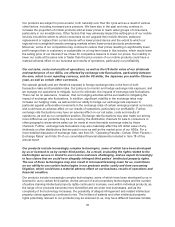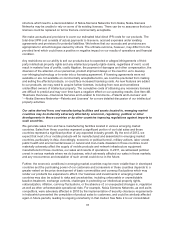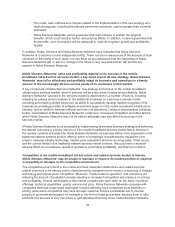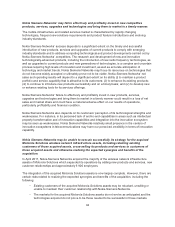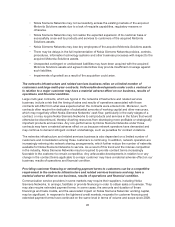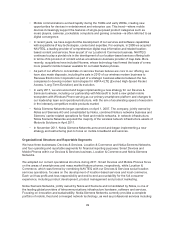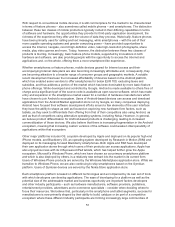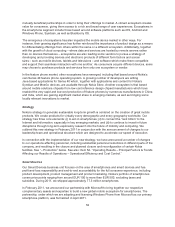Nokia 2011 Annual Report Download - page 46
Download and view the complete annual report
Please find page 46 of the 2011 Nokia annual report below. You can navigate through the pages in the report by either clicking on the pages listed below, or by using the keyword search tool below to find specific information within the annual report.Nokia Siemens Networks’ may fail to effectively and profitably invest in new competitive
products, services, upgrades and technologies and bring them to market in a timely manner.
The mobile infrastructure and related services market is characterized by rapidly changing
technologies, frequent new solutions requirements and product feature introductions and evolving
industry standards.
Nokia Siemens Networks’ success depends to a significant extent on the timely and successful
introduction of new products, services and upgrades of current products to comply with emerging
industry standards and to address competing technological and product developments carried out by
Nokia Siemens Networks’ competitors. The research and development of new and innovative
technologically-advanced products, including the introduction of new radio frequency technologies, as
well as upgrades to current products and new generations of technologies, is a complex and uncertain
process requiring high levels of innovation and investment, as well as accurate anticipation of
technology and market trends. Nokia Siemens Networks may focus its resources on technologies that
do not become widely accepted or ultimately prove not to be viable. Nokia Siemens Networks’ net
sales and operating results will depend to a significant extent on its ability (i) to maintain a product
portfolio and service capability that is attractive to its customers; (ii) to enhance its existing products;
(iii) to continue to introduce new products successfully and on a timely basis; and (iv) to develop new
or enhance existing tools for its services offerings.
Nokia Siemens Networks’ failure to effectively and profitably invest in new products, services,
upgrades and technologies and bring them to market in a timely manner could result in a loss of net
sales and market share and could have a material adverse effect on our results of operations,
particularly profitability and financial condition.
Nokia Siemens Networks also depends on its customers’ perception of its technological strengths and
weaknesses. For instance, in its perceived lack of end-to-end capabilities in areas such as intellectual
property transformation and of innovation capabilities and integration into the innovation ecosystem
may be seen as weaknesses. Nokia Siemens Networks relatively small presence in the centers of
innovation ecosystems in telecommunications may harm our perceived credibility in terms of innovation
capability.
Nokia Siemens Networks may be unable to execute successfully its strategy for the acquired
Motorola Solutions wireless network infrastructure assets, including retaining existing
customers of those acquired assets, cross-selling its products and services to customers of
those acquired assets and otherwise realizing the expected synergies and benefits of the
acquisition.
In April 2011, Nokia Siemens Networks acquired the majority of the wireless network infrastructure
assets of Motorola Solutions which expanded its operations by adding new products and services, new
customer relationships and approximately 6 900 employees.
The integration of the acquired Motorola Solutions assets is now largely complete. However, there are
certain risks related to realizing the expected synergies and benefits of the acquisition, including the
following:
• Existing customers of the acquired Motorola Solutions assets may be reluctant, unwilling or
unable to maintain their customer relationship with Nokia Siemens Networks.
• The markets for the acquired Motorola Solutions assets do not evolve as anticipated and the
technologies acquired do not prove to be those needed to be successful in those markets.
44



